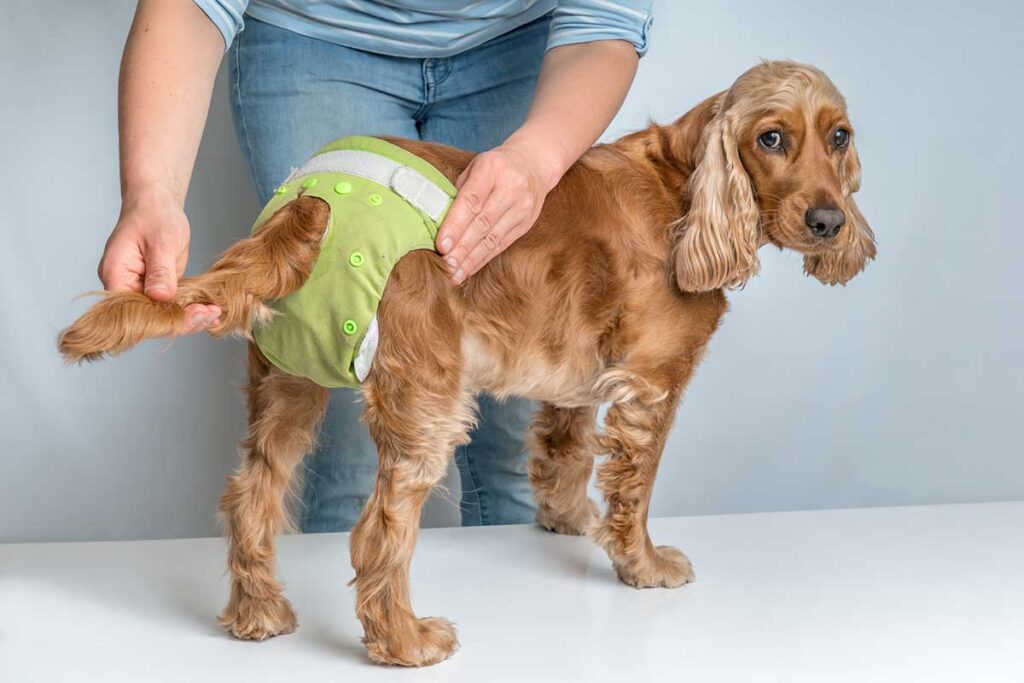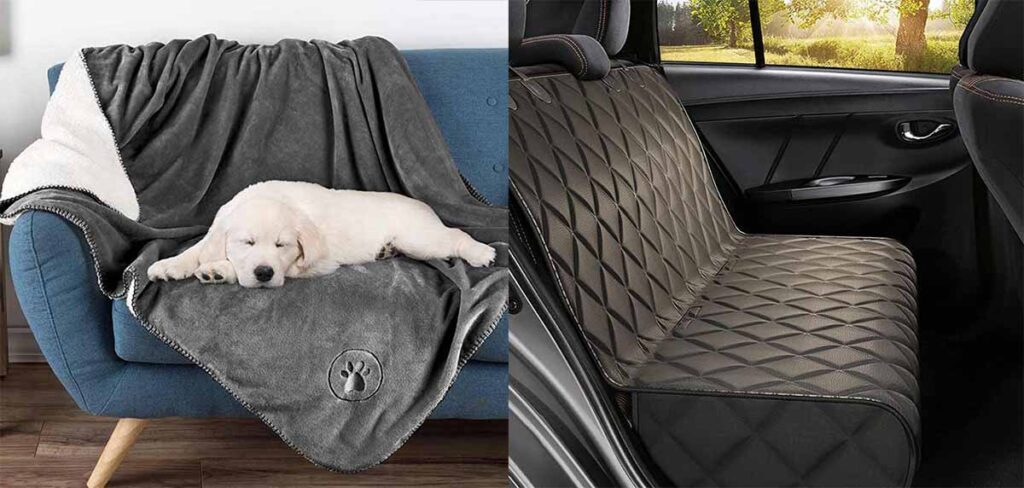
This article was updated on August 5th, 2022
Your situation:
✓ Your dog is a senior dog
✓ Your dog is aware that they are peeing inside the house
✓ Your dog is also drinking more than usual
(if this is not your situation, click here).
If your senior dog is aware that they are peeing inside – for example squatting to start the peeing process – and also drinking more than usual, it is an indication that they are suffering from a medical condition such as diabetes or cushing’s disease.
Let’s review the most likely conditions, and find out what you can do to help your dog avoid accidental peeing (Keep in mind that you should meet your veterinarian to do a full medical exam).
Most Likely Conditions Causing Your Dog to Pee Inside
Your answers are an indication that there could be a serious medical condition that needs your veterinarian’s attention. What could be causing your dog’s incontinence? Several conditions can cause an increase in drinking and … peeing, including:
1. Kidney Disease
Kidney disease is one such circumstance that would result in a dog drinking and urinating more as well as having accidents in the house. Kidney disease may be caused by infection, kidney stones or just general old age. The most common symptoms are:
- Excessive thirst
- Increased urination / peeing a lot
- Vomiting
- Diarrhea
- Lethargy
Many senior dogs have some degree of kidney disease (this means that their kidneys aren’t filtering out toxins from the blood efficiently). Two of the most common symptoms of failing kidneys are excessive thirst and increased urination.
But you’re likely to see both of these as symptoms of several other conditions, so don’t jump to the conclusion of kidney disease just based on this.
It is MORE common to see additional symptoms when the kidneys are involved, but this doesn’t ALWAYS happen. This is because a build up of toxins in the blood (because the kidneys aren’t filtering them out) results in systemic illness.
Kidney disease can be treated with many different medications depending on the underlying cause, which your vet will choose based on your individual dog. Your dog may also need intravenous fluid therapy to flush out excess urea in the blood.
Your veterinarian is the best person to determine the most appropriate treatment.
2. Diabetes Mellitus.
Diabetes can occur at any age, but it is more likely to affect senior dogs (Most dogs who develop this condition are 5 or older at the time of diagnosis).
Symptoms include:
- Excessive thirst
- Increased urination
- Increased appetite
- Weight loss
- Lethargy
- Repeated UTI’s
Two very common symptoms of diabetes in older dogs are increased thirst and increased urination. So, if your older dog is peeing in the house and seems to be extra-thirsty, diabetes could potentially be the reason why your old dog suddenly started peeing in the house.
This is a condition that you need to get under control otherwise it can cause serious health problems for your dog. It can even become fatal if left unchecked. If you notice these symptoms, get your old dog to your vet asap. Diabetes needs to be treated with insulin, which will probably require injections twice a day, as well as a diet change. Learn more on our page about diabetes in older dogs.
3. Cushings Disease
Cushing’s disease is a hormonal disorder that occurs due to your dog’s adrenal glands over-producing a natural steroid hormone called cortisol. This is because of a (usually benign) tumor that grows in the pituitary or adrenal gland.Cortisol is a stress hormone, so an overproduction of this results in your dog being in a constantly stressed state. This can produce all kinds of different symptoms, including increased urination.
Symptoms include:
- Excessive thirst
- Frequent urination
- Increased appetite
- Lethargy
- Thinning coat/hair
- Swollen belly
- Panting
- Loss of muscle tone/strength
There are two types of Cushing’s disease: pituitary dependent and adrenal dependent, depending on where the tumor is. Both forms of Cushing’s disease can be treated medically with either trilostane or mitotane, however, adrenal dependent Cushing’s disease is better treated with surgery.
Please note that there could also be other reasons causing your old dog to suddenly start peeing inside.
This is why we recommend that you consult with your veterinarian to determine correct diagnosis and next steps. It is also important that your vet rules out other serious conditions that could also cause your old dog’s peeing inside the house (such as diabetes or Cushing’s disease).
Other causes
The three conditions listed above are the most common causes of excessive drinking and urination in the house, but there are many other conditions that could cause this. These include but are not limited to liver disease, Addison’s disease, toxicity and neoplasia (cancer).
6 Ways To Help Manage Dog Incontinence – and Avoid Messes!
While you wait for your visit to the vet and experiment with treatment options to solve your dog’s incontinence, you can also do a few things to make life with a leaky dog easier for everyone. Sometimes, incontinence in dogs can’t be helped by medications/treatment and simply needs to be managed. In that situation, the focus is on products to make living with an incontinent dog easier:
1. Try Doggie Diapers: Doggie diapers will help protect your carpets, bedding and furniture from constantly being dripped on or flooded when your old dog is peeing in the house.

If Fifi only loses control when she’s sleeping, you can just put a diaper on her before it’s time for bed or when she’s taking a nap. If it’s a more constant dribble, then she may need to wear them for longer periods. View our favorite doggie diapers.
2. Be Ready for Dog Urine Clean-Up: Having the right urine odor and stain removal products at hand can make life a lot easier. Keep plenty of absorbent paper towels or old bath/hand towels in strategic places around your house for instant mop up. We have tried just about all of the most popular pet cleaning products: find the ones that have passed in-home testing in our list of favorite dog urine cleaning products.
3. Get a Waterproof Dog Bed: There are no totally waterproof beds, but our page about waterproof dog beds features those that are very good at repelling urine or have removable covers and waterproof liners.
4. Proof your House & Car with Waterproof Covers: If your old dog is regularly using your couch, bed, or car seats, consider waterproof sheets or rubber-backed sheets or blankets. View our recommended waterproof blankets. You can also buy a waterproof car seat cover for less than $40 on Amazon.

5. Place Doggy Potty Training Pads Strategically Around Your House: you can use disposable potty training pads (Amazon link) positioned under or next to your dog’s bed, or in strategic places around the house, to help make accidents easier to clean up. To help your old dog understand this new process, place a paper towel with a few drops of their urine over the new training pad.
6. Use Dog Urinary Health Supplements: natural supplements can help support healthy urinary tract function. They won’t stop incontinence, but they can help prevent it from getting worse as well as keep your dog’s bladder healthy.
In addition to vet-prescribed medications or procedures, a range of natural products are designed to help keep your dog’s urinary system healthy and functioning as well as it possibly can. There are many different options to choose from, including options from reputable, well-regulated manufacturers that we trust. View our recommendations for dog urinary health supplements or learn more about the best dog incontinence products.
How Do you Stop an Older Dog From Peeing Inside?
How you treat your old dog’s incontinence problems depends on what is causing the issue in the first place.
Depending on the cause, there are lots of effective remedies available for Fifi or Fido’s leaky plumbing issues, from medications and supplements, to surgery. Learn more about the best treatment options on our page about treatment options for old dog incontinence.
Learn about treatment options for old dog incontinence
Questions Your Vet May Ask You
A senior dog peeing in the house is often a symptom of a more serious condition. If your old dog is regularly peeing indoors, we recommend that you take him to your local veterinarian. You will want to be prepared to help your veterinarian diagnose the cause of your dog’s incontinence.
Questions Your Vet May Ask you: your veterinarian will first ask you several questions about the nature of your dog’s urinary issue, such as:
- how long has your dog been incontinent? is your dog generally well?
- how often is your dog peeing throughout the day? is your dog peeing more frequently now?
- is your dog straining to urinate (or is urine dribbling out)?
- is your dog drinking and urinating more than usual?
Bring a Urine Sample with You
your vet will thank you for it – ideally collected first thing in the morning as this will measure how well the kidneys are concentrating the urine. A urine sample can provide key insights into your dog’s health; by analyzing the urine for the presence of different components such as glucose, protein, blood cells and bacteria as well as testing the pH, your vet can get a really good idea for what might be causing the symptoms your dog is displaying.
Sometimes your vet may need to take a sterile urine sample directly from your dog’s bladder with a needle, especially if they are concerned about a urinary tract infection. While this sounds scary, most dogs tolerate it very well and sedation can be given if not.
Physical examination: Your vet will also perform a physical examination, assessing various body systems and looking for clues as to what might be causing the incontinence. However, there is only so much information your vet can acquire from the examination, and often further tests will be required.
Additional tests: In some cases, additional tests such as blood tests can be performed to help diagnose the condition. Key parameters can give an insight into how well the kidneys are functioning, white blood cells levels can help identify the presence of infection and hormone tests can help look for endocrine diseases that may be influencing the urinary system.
An ultrasound scan of your dog’s bladder and kidneys can identify possible structural changes that might be causing urinary symptoms such as incontinence. Your vet will look for abnormalities such as bladder stones or growths.
What to Do Next?
If you’ve noticed a pattern in your dog drinking more water and urinating more (and being aware of it), then you should have them checked out by your veterinarian. You can also go back to our main page about senior dogs peeing inside.
Important note: Please consult with your veterinarian to determine the correct diagnosis. There could also be other reasons causing your old dog to suddenly start peeing inside. It is important that your veterinarian performs a full medical exam of your dog to determine the correct diagnosis and treatment options.
Disclaimer: This website's content is not a substitute for veterinary care. Always consult with your veterinarian for healthcare decisions. Read More.



Be the first to comment